Fleet EV transition is made easier with EV readiness tools

Fleet operators require efficiency, learning over time to rely on their ICE vehicles. Knowing where vehicles are heading, when they will arrive, and the requirements they need to meet in the process, is a standard practice for logistics firms, but potential disruption forever looms around the corner.
Manufacturers and technology firms have been integrating solutions to manage fleets and plot the journey ahead as it happens, with data the main component of this. With electrified vehicles, though, a major opportunity has presented itself, allowing organisations to integrate faster and more sustainably.
The challenge here is adoption. Despite the best efforts of vehicle manufacturers and their value chains in bringing more innovative cars, vans, and trucks into the market, fleet operators must be willing to adopt. Time pressures are clear, but the cost to businesses remains questionable as electrification’s pros and cons echo along the supply chain.
Again, the key here is data. Supply chain organisations need to be more informed about the EV adoption process to effectively weigh up the cost of switching to this particular type of zero-emission transport. Concerns around charging infrastructure, range, and other aspects of electrification are what hold them back. As Barney Goffer, UK Product Manager at Teletrac Navman, explains, this presents risks on both sides.
Risk vs risk—the fleet electrification dilemma
Stagnance is the first potential risk to fleets—standing still in an industry where movement is key could cost more in the long-term as competitors look to leverage new technologies first. This is understandable in an industry that is more traditional in its approach to operations, but it’s safe to say, open-mindedness could mean the difference between winning the electrification race and being left behind.
On the flip side, the unknown is the unknown, and with new technologies—especially those reinventing conventional approaches—there will also be uncertainty, and those that accept the risks with their eyes wide open will prosper.
While the risk is inevitable, data is the educator in this process, and solutions like Teletrac Navman’s Electric Vehicle Readiness tool, provides the necessary insight to help fleet managers better educate themselves on their operations, leveraging greater visibility.
Aside from the operational concerns, consumers are also more and more preoccupied by the sustainability credentials of companies they buy from. This means that organisations are under pressure from both angles. They want their supply chain actions to be sustainable, and their customers want products to be provided at no cost to the planet.
“Consumers are extremely savvy, clearly, and we want to know that they're not impacting the environment necessarily. So, people are making decisions to buy from businesses that have strong green credentials that have a forward-looking organisation focused on exactly that—minimising carbon emitted into the atmosphere and their overall environmental impact,” says Goffer.
Track and trace settles some concerns
As fleet operators consider the potential impact of electrification on their fleets, it’s important to understand how track and trace can not only make EV adoption much simpler, but also allows companies to seamlessly integrate their vehicles into their digital ecosystems.
“It's important to know when a certain threshold is met for a particular vehicle so you can get it back out on the road straight away. The converse of that could be that you want to know if something is unlikely to meet its delivery slot, it's going to run the risk of actually running out of charge,” says Goffer.
Visibility of logistics operations is perhaps one of the most critical benefits of electrification. The ability to receive over-the-air updates and review data in real time allows organisations to adapt quickly and optimise their EVs.
“It’s about providing those critical data points that will alert automatically. You don’t want to have to sit there as a fleet manager and be looking for this; you want the system to actually tell you by exception when there is a risk,” Goffer explains.
The method of powering a vehicle should not determine a fleet. If managers can leverage the data provided by a particular type of vehicle or system, they are able to adapt and plan contingencies, making their supply chains more resilient to the world around them. Integration with software and access to navigation systems these days means that drivers in any context can plan ahead more effectively.
Transitioning a fleet to EVs is like preparing a room for a new-born child: it requires planning well in advance. If the correct facilities aren’t in place, or in the right place, when it comes to the big moment, the process is likely to be more stressful. Learning the works and understanding how the business will interact with EVs—and even putting some of those lessons into practice initially—will ease fleet operators in a more sustainable way.
Read the full fleet & commercial article in the April issue of EV Magazine.
- Voltpost Secures Grants for Nationwide Lamppost EV ChargersCharging & Infrastructure
- San Francisco Expands Curbside EV Charging ProgrammeCharging & Infrastructure
- How Amazon hit one Billion Electric Deliveries in the USFleet & Commercial
- Antimony Crisis: Challenges & Opportunities for EVsTechnology

